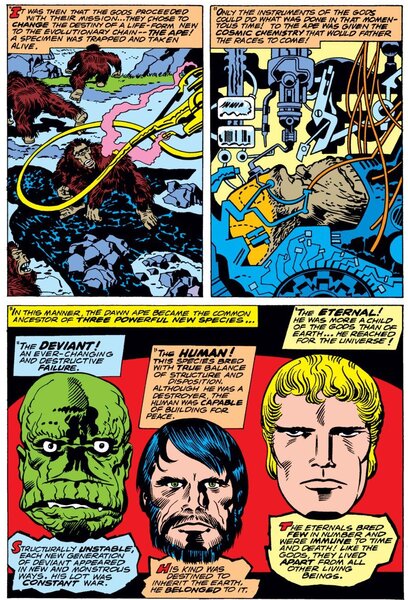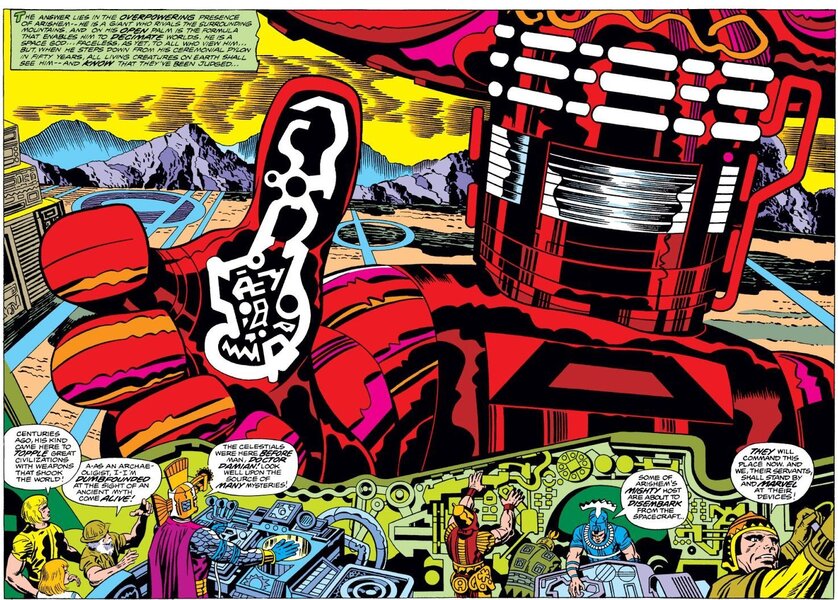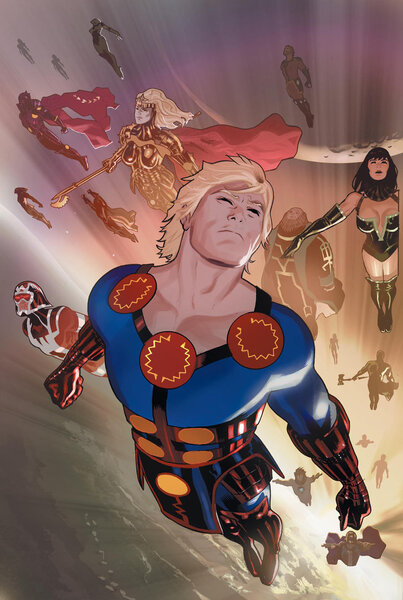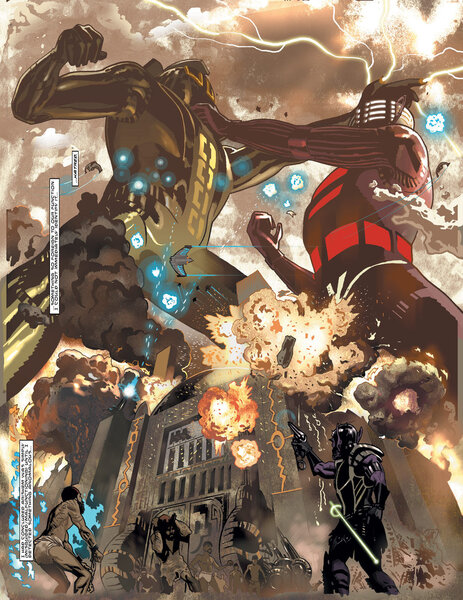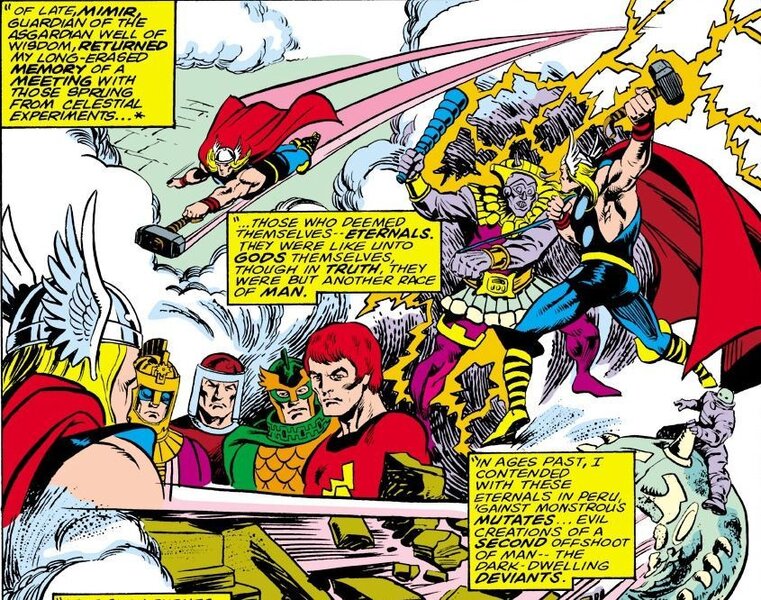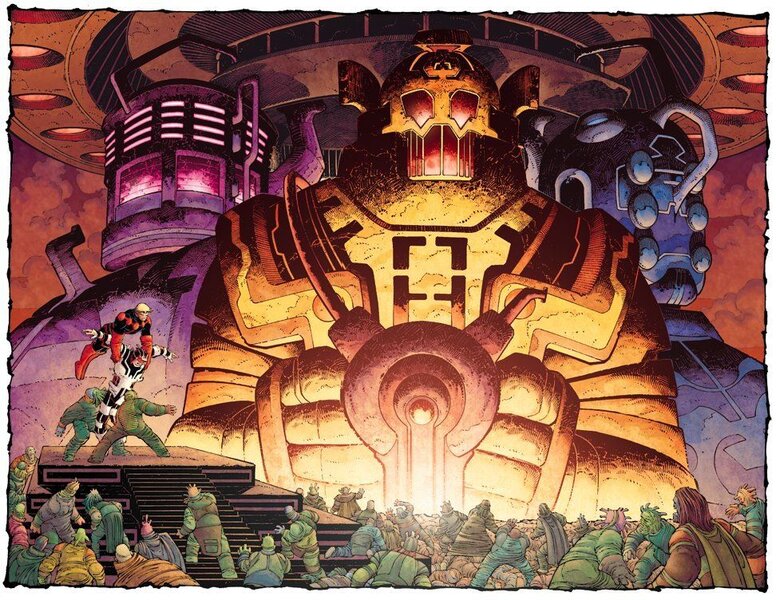Create a free profile to get unlimited access to exclusive videos, sweepstakes, and more!
Marvel's Eternals movie could reveal the birth of superheroes in Phase 4
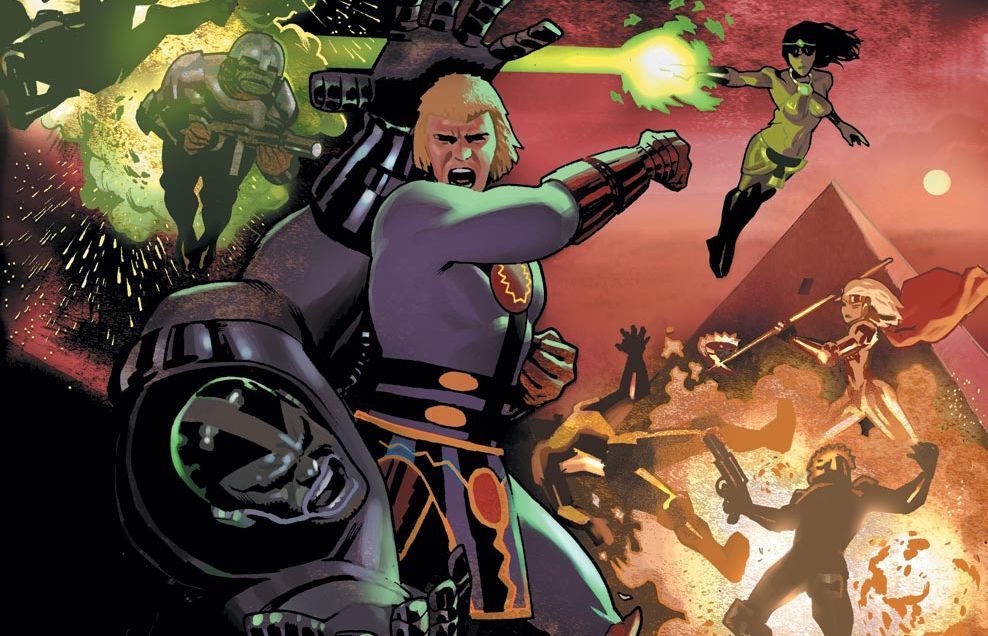
While casting rumors have been swirling around Marvel's Eternals for some time, the film is finally official and will premiere in theaters on November 6, 2020. Alongside the newly announced Shang-Chi movie, Eternals presents an opportunity to expand the MCU's future and history at the same time.
But who, exactly, are the Eternals? And what could this upcoming movie starring Richard Madden, Kumail Nanjiani, Lauren Ridloff, Brian Tyree Henry, Salma Hayek, Lia McHugh, Don Lee, and Angelina Jolie possibly be about?
In short, Eternals, at least in comic book form, is pretty much akin to Marvel's creation theory, centering around gods called Celestials seeding the superhuman gene throughout the universe. The Eternals themselves are the result of these experiments and wield a number of superpowers such as flight, super strength, energy blasts, teleportation, and mind control.
Having existed for millions of years, many of the Eternals tales center around their protection of Earth from the hordes of evil super-creatures known as the Deviants. Also created by the Celestials, the Deviants are bent on destroying the universe. Over the years, the god-like Celestials have been used to retcon the appearance of many superpowered beings throughout the Marvel universe, including mutants, superheroes, and even Thanos' race, the Titans.
In the original '70s The Eternals (which was canceled after 19 issues), series creator Jack Kirby explains that the Celestials approached Earth with a mission to "change the destiny of life." Using "cosmic chemistry," the Earth's apes are changed into three powerful new species: the humans, the Deviants, and the Eternals.
Created alongside the humans, the Deviants are an ever-changing "destructive failure" bent on war while the Eternals are children of the Gods, immune to time and death. Tasked with the protection of Earth, they live among humans but apart. In addition to Earth, the Celestials also visited other planets, including the Kree and Skrull homeworlds.
While Marvel has enjoyed some success developing relatively unknown properties like Guardians of the Galaxy, the Eternals are a step up in terms of a challenge. Whereas characters like Spider-Man, Thor, Captain America, Black Widow, and even Ant-Man have decades of comic book history to pull from, the Eternals simply don't. But that's not to say there aren't some great Eternals stories through the power of the retcon.
Amazingly, the MCU has already given us a look at two Eternals in previous films: Ego, the living planet, makes an appearance in Guardians of the Galaxy Vol. 2 and, of course, Thanos, who had Deviant roots in the comic books.
HOW THE ETERNALS CAME TO BE
To really understand the Eternals, it's best to look back to the mid-1970s and the rivalry between DC and Marvel Comics.
In 1974, legendary comic book creator Jack Kirby had recently created the New Gods for DC Comics but he was looking for a change. According to former Marvel EIC Roy Thomas, Kirby had approached Stan Lee and him at that year's San Diego Comic-Con about joining the company again.
A year later, Kirby had departed DC and was busy at work on the Eternals, writing, plotting and drawing the book on his own. The only other artists on the book were inkers Mike Royer and John Verpoorten, as well as colorist Gynis Wein. With the launch of The Eternals, Kirby was given full reign to do whatever he liked. Annoyed by the interconnectivity of characters within Marvel Comics, Kirby insisted the book not be part of the shared Marvel Universe and let his imagination run wild.
"We both felt that it was better to have Kirby back at Marvel than DC or elsewhere... even though neither of us was wild about the prospect of his writing dialogue as well as plotting and drawing," Thomas said. "Still, there were a lot of good things about Jack's 1970s Marvel work, especially a concept or two like The Eternals."
WHO ARE THE ETERNALS?
With news out of SDCC that Chloé Zhao will direct Marvel's Eternals with Jolie, Nanjiani, Madden, and Hayek all in lead roles, production on the film is clearly well underway. According to the announcement, Jolie will play Thena, Madden is Ikaris, Nanjiani is Kingo, Ridloff is Makkari, Henry is Phastos, Hayek is Ajak, Lee is Gilgamesh, and McHugh is Sprite.
In Kirby's original series, the Eternals are led by Ikaris, who possesses the powers of flight, teleportation, psychic abilities, and the power to project cosmic heat beams from his eyes or hands. When the Celestials return, triggering a world-ending threat from the Deviants, Eternals Sersi, Makkari, and Thena reunite to put down the villains.
In addition to their individual superpowers, the Eternals are able to manipulate cosmic energy like their creators. When any three Eternals unite, the trio can unleash the Unimind, an amplified burst of power born from the Celestials. The original Kirby series feels and reads very much like ancient Roman and Greek myths, with many of the Eternals' names and superpowers being plays on established mythology. For instance, Thena (a take on Athena) can shoot beams of heat and light while Makkari (Mercury) is incredibly fast.
Since they were created by Jack Kirby in 1976, the Eternals have been used sparingly by Marvel creators through the years and many of their tales have been relegated to various miniseries.
Aside from Ikaris, Sersi is the most well-known Eternal and appearad in the second issue of Kirby's run. Having spent years fighting alongside the Avengers in the comic books, she's got the most history to play with. After several team-ups in the 1980s, Captain America asked Sersi to join the team full time in 1990. Easily one of the most powerful Avengers (boasting transmutational abilities and and the power to rearrange the molecular structure of objects), Sersi helped take out some of the team's most dangerous foes. During this time, Sersi began a relationship with fellow Avenger Dane Whitman, eventually departing for another dimension at the end of the run.
Phastos first appeared in Eternals, Vol. 2 #1 in 1985 and is the weapon smith. Mistaken for the Greek god Hephaestus, he is typically more reserved than his superhero bretheren. Additionally, he serves as the "tech guy" for the Eternals, having created numerous weapons and tools for them throughout the millennia.
Makkari is also tech savvy, but as one of the fastest people alive, he's usually running around trying to save the world instead. Taught by one of the elder Eternals, Master Elo, Makkari also provides his fellow superheroes with advanced, high-velocity vessels.
First seen in the pages of Kirby's original Eternals series (#11), Kingo is a student of the Samurai and spent most of his time in Japan in the 16th century studying swordplay. In updated versions of the character, he's become an action film star with a sharp wit. In addition to his skills with a sword, he's got super strength, the ability to fly, and, of course, hand energy beams.
Finally, the Peter Pan of the group, Sprite, is considered the jester and trickster of the Eternals. Unable to grow, he's perpetually a pre-teen in the comic books, leading the character to lash out in unexpected ways.
READING LIST
Thor (1980)
Although enjoyable, Kirby's initial Eternals run was left in a lurch by its cancellation. Several plot points were simply left hanging until Roy Thomas came along as a writer on Thor. According to Thomas, he was enjoying his late turn on Thor when Marvel suggested he integrate the Eternals fully into the Marvel Universe. In this storyline, Thor flashes back to an encounter with the Eternals and Celestials from 1,000 years ago.
"I enthusiastically concurred, because I liked the basic idea of The Eternals at least as much as I had The New Gods, and I set about to do it. So it was Marvel's idea more than mine to use them, but it fit well with something I enjoyed doing," Thomas said. Joining Thomas on writing duties throughout the run were Ralph Macchio and Mark Gruenwald with art by John Busema, Keith Pollard, and Arvelll Malcolm.
Eternals (1985)
Written by Peter B. Gillis and Walt Simonson and illustrated by Sal Buscema and Keith Pollard, Marvel relaunched the Eternals in the mid 1980s with Eternals. In this series, Gillis (and later Simonson) dealt with the fallout from their leader Zuras in Thor #300, as well as the fact that most of the Eternals had joined together to explore the universe as the Uni-Mind.
In the story, Thena assumes the throne of the Eternals only to be challenged by Ikaris. Additionally, this series introduced two new Eternals, Phastos and Kingo.
Eternals (2006)
An updated take on the Eternals, Neil Gaiman's story focused on Ikaris, who, like many of the Eternals, had forgotten who he was. Joined by artist John Romita Jr., Gaiman relaunched the ancient heroes back into the Marvel Universe when Ike Harris rediscovered his ancient powers. Reading more like a drama than a comic book, Gaiman's interpretation also retconned the purpose of the Deviants, a shocking twist that still sits uncomfortably.
Iron Man Annual #6 (1983)
In the 1980s, there was a time when Colonel James Rhodes had assumed the duties of Iron Man. In 1983, writer Peter Gillis and illustrator Luke McDonnell took Rhodey on an adventure to Olympia, home of the Eternals. Things turned south when the Deviants attack him and he was left to save a room full of imprisoned Eternals. Albeit dated, the story provides an interesting look at the relationship between the Eternals and their galactic technology.
Eternals: To Slay a God (2008)
Beautifully illustrated by Daniel Acuna and written by Charles and Daniel Knauf, To Slay a God focuses on a Deviant plan too use Makkari to awaken the Dreaming Celestial. Combining the established Eternals mythos with an updated take on their relationship to the Celestials, To Slay a God centers around the Eternals' quest to reunite with their brother and stop the horde from devouring the earth.
Marvel Eternals premieres in theaters on November 6, 2020.
